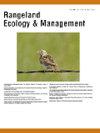大西洋森林总初级生产力动态:遥感和微气象视角
IF 2.4
3区 环境科学与生态学
Q2 ECOLOGY
引用次数: 0
摘要
大西洋森林是生物多样性热点和关键的碳汇,正受到森林砍伐和破碎化的威胁。本研究利用19年的中分辨率成像光谱仪遥感数据(2001-2020年)和3年的微气象塔数据(2018-2020年),评估了巴西最古老的保护单位之一意大利亚亚国家公园(PNI)的总初级生产力(GPP)。通过整合植被指数(Enhanced vegetation Index [EVI]和归一化植被指数(Normalized Difference vegetation Index))和光合有效辐射(PAR)的模型估算GPP,并利用FLUXNET数据进行验证。季节分析显示,雨季的GPP值较高,在9月达到峰值8.07 g C m⁻²天,而农业地区的GPP值最高,年平均值在9.00 g C m⁻²天。时间趋势表明,所有土地利用类别的GPP都在下降,其中植物避难所的减少最为明显(Zmk = −1.65,P <; 0.10)。在检验的模型中,使用EVI和PAR的GPP方程精度最高(R² = 0.49,d = 0.89,估计的标准误差 = 1.91)。该研究强调了遥感和微气象数据在监测生态系统健康方面的有效性,并强调了保护单元在固碳中的作用。这些发现支持将保护区纳入碳市场倡议,强调其对生物多样性保护和减缓气候变化的价值。本文章由计算机程序翻译,如有差异,请以英文原文为准。
Atlantic Forest Gross Primary Productivity Dynamics: Remote Sensing and Micrometeorological Perspective
The Atlantic Forest, a biodiversity hotspot and critical carbon sink, is under threat from deforestation and fragmentation. This study evaluates gross primary productivity (GPP) in the Itatiaia National Park (PNI), one of Brazil's oldest conservation units, using 19 years of Moderate Resolution Imaging Spectroradiometer remote sensing data (2001–2020) and 3 years of micrometeorological tower data (2018–2020). GPP was estimated through models integrating vegetation indices (Enhanced Vegetation Index [EVI] and Normalized Difference Vegetation Index) and photosynthetically active radiation (PAR), and validated against FLUXNET data. Seasonal analysis revealed higher GPP values during the rainy season, peaking at 8.07 g C m⁻² day⁻¹ in September, while agricultural areas exhibited the highest GPP, with annual averages above 9.00 g C m⁻² day⁻¹. Temporal trends indicated a decline in GPP across all land use classes, with the most pronounced reduction in vegetative refuges (Zmk = −1.65, P < 0.10). Among the models tested, the GPP equation using EVI and PAR yielded the highest accuracy (R² = 0.49, d = 0.89, standard error of estimate = 1.91). The study highlights the effectiveness of remote sensing and micrometeorological data in monitoring ecosystem health and underscores the role of conservation units in carbon sequestration. These findings support integrating protected areas into carbon market initiatives, emphasizing their value for biodiversity conservation and climate change mitigation.
求助全文
通过发布文献求助,成功后即可免费获取论文全文。
去求助
来源期刊

Rangeland Ecology & Management
农林科学-环境科学
CiteScore
4.60
自引率
13.00%
发文量
87
审稿时长
12-24 weeks
期刊介绍:
Rangeland Ecology & Management publishes all topics-including ecology, management, socioeconomic and policy-pertaining to global rangelands. The journal''s mission is to inform academics, ecosystem managers and policy makers of science-based information to promote sound rangeland stewardship. Author submissions are published in five manuscript categories: original research papers, high-profile forum topics, concept syntheses, as well as research and technical notes.
Rangelands represent approximately 50% of the Earth''s land area and provision multiple ecosystem services for large human populations. This expansive and diverse land area functions as coupled human-ecological systems. Knowledge of both social and biophysical system components and their interactions represent the foundation for informed rangeland stewardship. Rangeland Ecology & Management uniquely integrates information from multiple system components to address current and pending challenges confronting global rangelands.
 求助内容:
求助内容: 应助结果提醒方式:
应助结果提醒方式:


